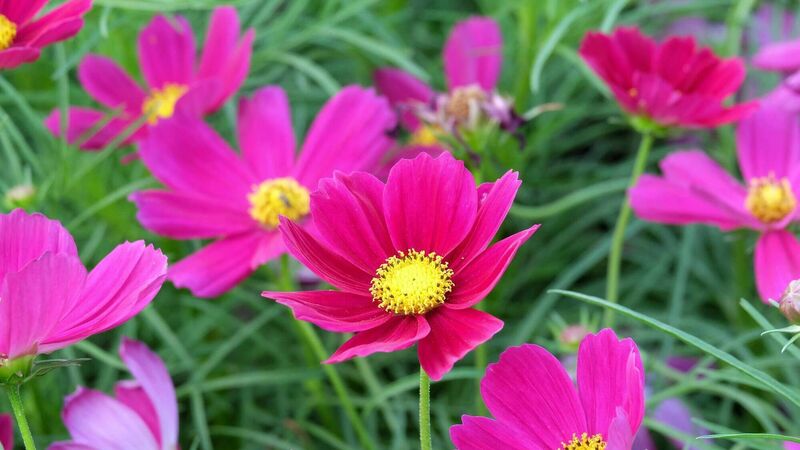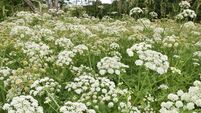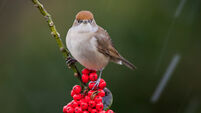Peter Dowdall: Cosmos is in the pink for autumn

Cosmos is an annual plant and as many other annuals are now finished or finishing, it is only now at its best, writes Peter Dowdall. File picture
Aren't cosmos great? Such cheerful and beautiful blooms in the September sunshine, so forgiving of, or even thankful for, all the rain and poor weather during the summer months.
As the crisp mornings and cooler evenings of autumn begin to creep in, the garden begins to slow down and flower colour begins to fade as we divert our gaze to the autumn foliage. However, one of the most vibrant and resilient stars of the late summer and autumn garden is the cosmos flower.
Cosmos is an annual plant and as many other annuals are now finished or finishing, Cosmos is only now at its best. Alongside cosmos, some other annuals like ammi, calendula, and some tagetes also extend the garden's colour into September and October.
Cosmos bipinnatus is the species that we grow for the very simple, daisy-like blooms and their ability to thrive even in the cooler days of late summer and early autumn. They have beautiful, delicate-looking, airy, feathery and fernlike foliage along with masses of flowers in shades of pink, white, red and purple.
They start flowering in mid-summer and continue through to the first frost. They will tolerate some shade but in truth, the sunnier the aspect, the better the display that they will give.
They are really easy to grow from seed, which you can sow now or in the early spring in seed trays or small pots indoors. Because I am a lazy gardener, I scattered mine directly on the soil earlier this year, in late March. Now those seeds have developed into flowering plants between 40cm-60cm in height.
Ammi is another excellent plant for extending the garden’s appeal into the cooler months. Often referred to as Queen Anne’s lace or wild carrot, ammi offers a delicate contrast to the more vibrant blooms of cosmos. It’s more muted, with simple umbrella-like clusters of white or greenish-white flowers, very wildflower meadow-like in bloom, again with beautiful, ferny foliage.
The fine, fern-like foliage and airy flower heads of ammi make it a really popular plant with floral artists and flower arrangers. I am, in no way a floral artist but even I can pick some ammi and cosmos and put them in a vase or even a simple jam jar to create a really gorgeous little display.
Calendula officinalis, known as the English marigold or pot marigold, is still awash with bright, cheerful blooms in shades of orange and yellow. This is another, traditional plant and used by many for its medicinal properties. However, for me it’s for the colour and to attract bees and other beneficial insects.
As the blooms of all these plants fade away and the plants die off later in the year as temperatures plummet, you don’t have to say good bye to them forever, as they will all set seed freely and it is a very simple job to collect these and grow more plants for free next year.
This is a job for the kitchen table, cover it with newspaper or similar first and then head outside once the flowers have fully dried on the plant. The seeds are ready for collection when the flower heads are brown and dry.
If the seedheads are still a bit green or damp, place them in a paper bag to dry further for a few days or perhaps, weeks.
Collect all the seed heads, bring them into the table and gently shake or tap the flower heads to release the seeds.
Store seeds in a paper envelope or a breathable container in a cool, dry place.
For a head start and to have larger plants to plant out earlier next year, sow seeds indoors during autumn and early winter in seed trays or pots filled with seed-starting mix.
Mist the compost with a small sprayer so the soil is consistently damp but not waterlogged and once germinated make sure they see enough natural light to develop.
You can keep sowing them indoors during the winter and into spring which means that you will have lots of plants at various different stages of development to plant out in early summer meaning that they will all be ready to flower at different stages too, extending the season of colour even more.
When we are out the other end of winter and into late spring, gradually acclimate your little baby plants to the great outdoors by exposing them to the elements for a few hours each day before planting them in their permanent location once the risk of frost has passed.
Alternatively, if this all sounds like too much work, just be like me and direct sow seeds outdoors once the risk of frost has reduced and the soil temperature has warmed up.











